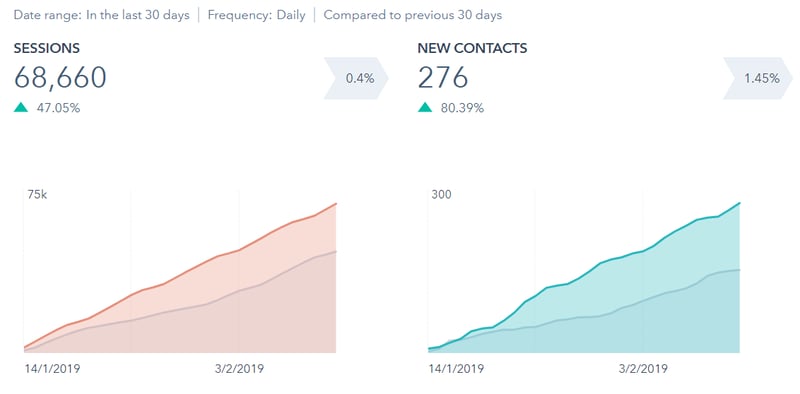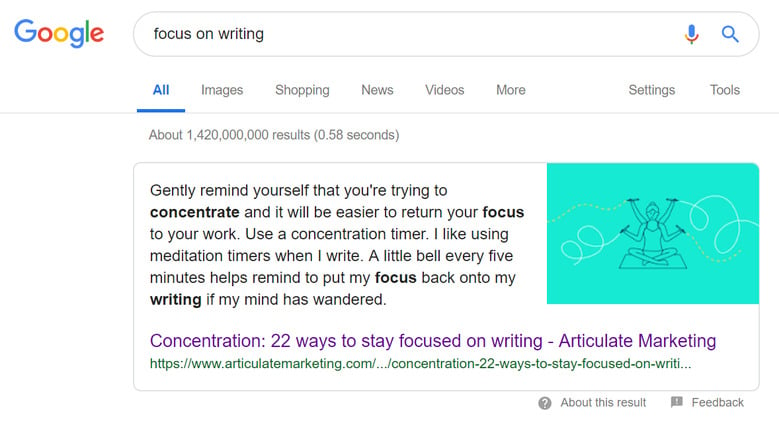Disclaimer first. Blogs don’t come with a formula. No matter how finely you crunch the data, you will not find this secret prize buried in the dust at the bottom of the cereal box. Content is fickle like that. But, we’ve learned that with a few data-informed decisions, you CAN increase your chances of having a successful blog.
Here’s how we did it.
Benchmarking our own HubSpot blog
With the help of our in-house analytics team, we analysed the data for our own HubSpot-hosted blog. We looked at successes and failures. We rooted around for correlations, comparisons and causations. Our conclusions are open to contest. A few results surprised us; many confirmed what we had already suspected.
We took some of this learning and applied it over the last few months. The results so far?
- 10,000 more visitor sessions this month compared to our batting average over the previous year, and
- An 80 percent increase in contacts this month versus the previous month.

Percentage-wise, what we’ve done with our traffic in a couple of months in 2019 took us a year in 2018. Naturally, the key is going to be maintaining and building on this success.
If you want to achieve similar results for your HubSpot blog, we’re happy to show our working and reveal the secret sauce. Get a full benchmarking and analytics service for your business’s HubSpot blog FOR FREE, right now.
Click here to find out more:
With your appetite suitably whetted, we should move on from the ‘why’ to the ‘how’. These points are based on our blog and our audience, so results may vary for you. However, this information should be helpful to any B2B blogger, whether they’re using HubSpot or not (though we can’t recommend this platform enough).
1. Everything starts with traffic
This is a fairly obvious point, but traffic begets leads. You can’t expect to get conversions without first building up your profile and generating traffic. This will do three things:
- Grow your authority as a business. It’s what everyone wants, right? Fame, fortune and nice legs.
- Improve your domain ranking, which will boost the chances your content will appear in Google search results (and this creates more traffic… it’s a cycle).
- Increase the number of leads via referrals – a share on social media or a back link from another blog, for example, can land you right where you need to be.
So, top-of-funnel blogs are the way to go to generate traffic. We split our time between traffic-growing blogs and more targeted lead-converting blogs, so we can get the best of both worlds. A great place to start is to define which of these goals you are aiming for when creating a new piece of content.
Here are some of our most successful, high traffic, top-of-funnel blogs:
- The essential guide to choosing good project names – 143k views in the last year
- What does a copywriter do: the B2B content marketing guide – 51.5k views in the last year
- How to write faster – 38.5k views in the last year
Yes, the project names blog is a runaway success. It’s well-positioned for our techy B2B audience, a great read, useful… just like our other top blogs.
It’s worth bearing in mind that this year we also took a risk. Historically, we were a copywriting agency, but as we grew and developed into a brilliant inbound digital marketing agency, we found our blog content needed to change to reflect that. We used to only write content about PR, journalism and copywriting:

Since then, we’ve slowly retargeted and refined our content for the audience we want to reach now. This had the potential of alienating our readership, but it needed to be done. Our content is now more aimed at B2B organisations, looking at topics beyond writing, like marketing strategies, SEO and website optimisation:

We grew our traffic by an incredible 38 percent this year (at time of writing) versus last year, and our conversions by 22 percent. The risk paid off. We fully expected growing pains that didn’t actually materialise. Don’t mistake ‘top-of-funnel’ for ‘unfocused’ – be bold and be targeted. Get the right traffic in the door. The customers will follow.
2. Quality trumps quantity every time
|
Top 10 Ranking - Articulate |
Average |
Top posts |
|
Average of Page Views / Day |
7.69 |
89.4 |
|
Average of CTA Clicks / Day |
0.07 |
0.96 |
Hark – a table.
On average, our top 10 blog posts get 89.4 views per day each compared with just under eight views on average for all our blogs. And, a similar story plays out when it comes to click-through-rates on our calls-to-action (CTAs – these are images or buttons that lead to a landing page for people to download a premium piece of content, like a white paper or calculator).
You’d expect this kind of positive correlation between views and engagement. The take-away here is that putting in the effort to write one exceptional blog that is targeted, entertaining, evergreen, SEO-optimised and helpful can get you more than 10x the contacts and views versus the average blog post.
With that information in mind, which option would you choose?
- Writing a business blog in-house as a side gig. After all, it’s just blogging.
- Hiring a freelancer or content farm to churn out blogs on the cheap.
- Working with professional marketing copywriters that can create this kind of top-performing content.
It doesn’t take many blogs to transform your marketing. They just have to be good ones. Normally, two-thirds to half of our traffic on any given month comes from the top 10 blog posts on our site. These blog posts get thousands of views every month.
3. Not all traffic will convert
There is a strong positive correlation between traffic and conversion, but we’ve found that – at least, on our blog – CTA clicks are not going to be an exact one-to-one match for traffic.
|
Correlations - Articulate |
Page Views / Day |
|
CTA Clicks |
+86.2% |
If a blog post increases in traffic from one month to the next, we can expect to see an increase in CTA clicks, but not by as much, by percentages. Now, is that normal? Possibly. Probably. But, if you have a long-established blog like ours, you can take this information as an opportunity to turn your focus from traffic to lead generation and lead nurturing.
Here’s what we’ve done to increase our conversions so far in 2019:
- Built a brand-new automated email lead nurturing strategy.
- Combed through our blog to ensure up-to-date and relevant CTAs are evenly distributed throughout (also, we used some clever HubSpot hacks).
- Added CTAs and social sharing buttons to a sticky sidebar on our blog.
- Updated all our landing pages and thank you pages, based on best practice research.
- Re-branded our CTAs. For example - did you know we can help you with your marketing strategy? How ‘bout that? Just click below:
And, we’ve got loads more ideas. Will this improve our correlation between traffic and conversions? We’ll have to wait and see, but, the data certainly sparked actions that seem to be generating not only more leads, but more qualified leads. When we know more, we’ll probably write a blog about it.
4. Longer is better and social shares increase read-time
On average the blogs on first page of Google have 1,890 words. Generally, longer content is more likely to be valuable. Of course, we don’t mean pad your work. Instead, put time and effort into producing high quality pieces with lots of useful, well-researched information.
Overall, we’ve taken this information to heart for some time. Our average blog post has 1,066 words with a four-and-a-half minute read time (265 seconds), which is pretty sizeable.
Our top blogs are longer
As you might expect, we’ve found that our top 10 blogs by views are longer than the average, with 1,232 words. Now, we have added more content to these blogs as they’ve grown in popularity, so even taking out our very long outliers we see our top 10 blogs with 120 words more than average, with an over five-minute read time.
By organising our content around longer ‘pillar pages’ with clusters of shorter supporting blogs, we are building our image as a comprehensive authority on certain subjects and optimising SEO links in our site. And, even tackling short, high-search volume keywords. Try searching for ‘copywriter’ – you’ll see.
Share longer blogs on social media
The top 10 posts based on social media shares are about a hundred words longer than the average. They also have slightly higher average read times compared to word count:
|
Posts |
Average of No. Words |
Average of Reading Time (s) |
|
Top 10 Shared (Twitter) |
1,175.00 |
293.00 |
|
Top 10 Shared (Facebook) |
1,184.43 |
303.57 |
This shows that when people come to our blog from clicking a link on social media, they are more likely to spend longer on the page and be more engaged in the content.
5. Top blogs contain more headers
A blog needs to be written with two readers in mind: the human and the robot. It turns out, both like reading blogs with a clear layout and lots of headers. (H2 or H3 tags, please – don’t go crazy with H1 tags! We’ll let Neil Patel explain why).
|
Top 10 Ranking - Articulate |
Total |
Top Viewed |
|
Average of No. Headers |
9.71 |
12.6 |
Humans like reading headers because…
According to this study on how people read media online, ‘users are quite content just reading the heading and summary to grasp the meaning of an article.’
We skim-read online content, which is something we’ve talked about before. To write a compelling blog, we’ve found clear success with lots of:
- Headers. These give the vertically scrolling reader something to latch onto and increase the chances that they will keep reading.
- White space. UX and content work well together. You want to give people room to breathe.
- Bullet points and lists. This puts information into clear, digestible chunks.
- Bold text. People bounce around when they read. In a long paragraph they might see a bold phrase and jump back to the start of the paragraph to get more context. Without the bolding, they might skip that paragraph altogether, because tl;dr.
Robots like reading headers because…
Headers make it easier for search engines to parse content and figure out what it’s all about. If your blog uses too few, overly prosaic or generic headers, then this could affect your SEO and the chances of you having a truly successful blog.
And, there’s the advent of Google’s featured snippets to think about. Headers can help you get that all-important top spot with a list:

Or, simply because the subsequent content is packaged into neat, pithy paragraphs:

6. Higher ranking blogs have better backlink profiles
‘Ahrefs URL Rating (UR) is a metric that shows how strong a backlink profile of a target URL is on a scale from 1 to 100.’
Ahrefs is a brilliant tool for delving into some of the data that we have on our blog. We found that a good URL rating correlates positively with page views, so blogs with high quality backlinks tend to have higher views. And, our top posts have a higher URL rating than the average, which back up this theory nicely.
Now, this can be a bit of a self-fulfilling prophecy. Good backlinks mean more views which means more of a chance of getting more backlinks and so on. But, it’s worth noting that (ethical, non-spammy, humane) link building should form part of your blogging strategy if you want to write successful blog posts.
|
URL Rating |
+25.0% |
|
Top 10 Ranking - Articulate |
Total |
Top Viewed |
|
Average of URL Rating |
15.6 |
20.7 |
7. More referring domains is an indicator of quality
Our best blogs have more than twice the number of referring domains as our average. Google really likes it if you have more referring domains because that means that your content is being linked to by more people and is therefore more likely to be genuinely valuable. Think about it. If you’re the authority lots of others are pointing to, you must be doing something right.
You might be wondering – surely, I can get the same effect if I get lots of backlinks? The answer is no. Referring domains and backlinks are not the same thing. In fact, search engines will punish your content if they see it has a lot of backlinks from few referring domains, because this could be a sign of backlink farming.
8. Relevance is key – and social media speaks to the masses
We found page views also correlate positively with social media engagement. Again, the process is cyclical: more shares equals more views; more views equals more shares. But, along with organic search and email marketing, social media is an absolutely vital part of getting your blog out in front of your audience.
|
Social media |
+20.8% |
Over the last year, we’ve ramped up our social media strategy, putting a lot of time into research and development. The results? Well, our favourite one is Twitter, where we went from 16.7k followers to a whopping 23.5k followers in just one year. That’s nearly seven thousand additional followers!
When it comes to social media, here are five key things to remember:
- Be mindful about how you write social posts. The little things do matter.
- Use the right hashtags and research what hashtags your audience is using.
- Plan a social media strategy to post relevant or even event-driven content.
- Use automation tools wisely for sharing your own blogs and curating others’.
- Be human on social media. Engage with people. Like. Share. Retweet. Comment.
9. Old content is your greatest resource
If you want fifty percent more traffic on your blog, try overhauling your old content. That’s what we did, and it absolutely worked.
Get rid of the rubbish
There’s an old saying among writers: ‘kill your darlings.’ We got rid of about eighty blogs, and in the past, we’ve dumped a whole load more onto the rubbish heap. This can feel scary. It can feel counter-intuitive. But it works. Ask yourself, is this blog post:
- Not getting traffic?
- Irrelevant?
- Poorly written?
- Too short?
- Outdated?
Kill it, darling! It’s not helping your traffic or your conversions and it’s distracting Google from parsing the good stuff.
Franken-post
If you’ve got two or three blogs that cover similar ground, why not put them together? Longer, high-quality blog posts are much more likely to reach page one of Google than a bunch of short ones. Also, those shorter blogs could be competing with one another for the same keywords, which doesn’t help.
Polish till it shines
We edit our blog posts all the time. Sometimes, so much so that we republish them. We want our links to work, our content to remain relevant, our tone to stay consistent, our facts to be up-to-date and our statistics to be accurate. KonMari your blog on a regular basis and you will see a massive return for minimal effort. But don’t forget to redirect deleted URLs to existing posts so you don’t break any incoming links.
Add extras or recycle content
This is what happened when we added a project name generator to this blog post.

By adding to your most successful posts or by recycling old content into something new, like turning it into a video, infographic or podcast, you add value.
It’s worth the effort.
10. We got better at blogging
We wanted to know: what’s changed between 2017 and 2018? Here’s the highlight reel:
Our top 10 blogs by views saw an average increase of 10,000 views and we nearly doubled our average CTA clicks.
We added a considerable amount of copy to a blog about copywriting that was already doing well, and saw it get 20,000 more views in 2018 than 2017, and a whopping 402 more click throughs.
Ironically, a blog called how to increase your organic site traffic didn’t even make the top 10 in 2017, but soared up the charts in 2018, and is number five for CTA clicks.
We saw just under 500,000 views on our site in 2017. In 2018? 660,000. And, even if we don’t improve on what we’ve done so far in 2019 – which of course we totally will – we expect to see 800,000 people to visit us this year. (Update: over 833,000 people came to our site in 2019.) You’ll be one of them. Welcome to the party: you’re in good company.
Why has our blog been so successful?
There are a hundred reasons why we found such success in 2018, but here’s just a few:
- We are writing more targeted, persona-driven content.
- We are constantly updating our best content and getting rid of the rest.
- We create content with SEO as a forethought, not an afterthought.
- We do a lot of up-front planning before we write, and a lot of editing after.
- We are patient, and we think ahead.
They say, ‘dress for the job you want’. We say, write for the blog you want. The content we wrote in 2017 and earlier is the stuff that is seeing success now. Inbound marketing is a marathon, not a sprint. Saying that, we’re really looking forward to producing a similar report in 2020, and to benchmarking other businesses as well. More data means more insights that we can use and share with the world.
So, do you want your Hubspot blog analysed now?
As an experienced HubSpot partner, we work with client portals on a daily basis (mostly B2B tech companies). We know our way around a HubSpot blog, and, we pride ourselves on making data-informed decisions to improve our own content, and the content of our clients. If you want to benchmark your blog and get recommendations, click below:
In a world of hype, fake news and BS, we do things differently. We empower people to make better decisions with clear-sighted communication and marketing.
We are Articulate.
 Posted by
Maddy Leslie
Posted by
Maddy Leslie







